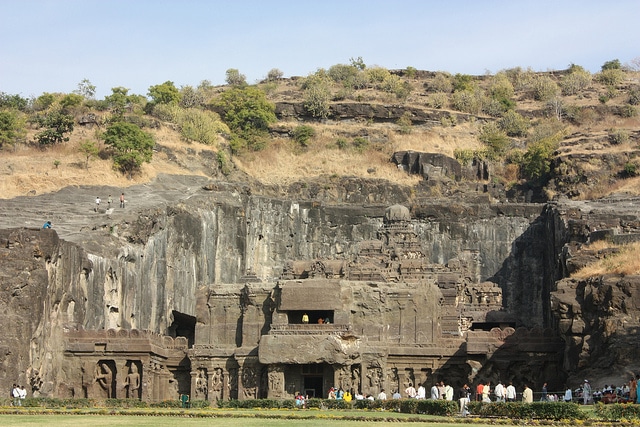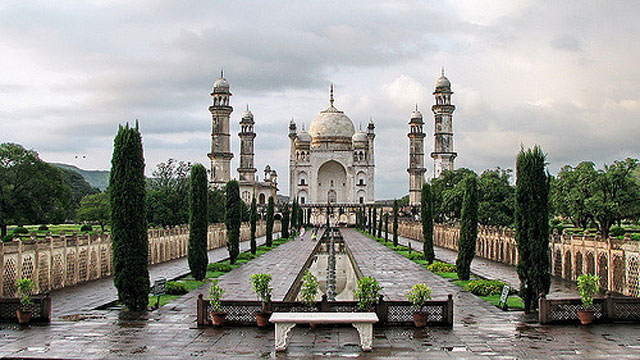Maharashtra is a state where you will find at least one historical monument in each of its corners. Thus, it can be said that there are hundreds of monuments in the state that are renowned worldwide and many of these are thousands or more years old. Since Emperor Shivaji is synonymous with Maharashtra’s history, each of the forts associated with him, some built by him, or many which he conquered or stayed are undoubtedly some of the most famous historical places in the state. Be it Raigad, his birth place, Lal Mahal where he spent his childhood, or the other forts such as Lohgad, Pratapgad, Murud Janjira, Singhgad, Sindhudurg and many more, are definitely the must-visit forts in Maharashtra. Then, there are places that are associated with freedom struggle which are other revered historic spots in Maharashtra.
Hence, it is very difficult to pick just 5 among the hundreds of historic monuments and that is why the 5 monuments listed are selected on the basis of its history, its heritage value, architectural splendor and also its worldwide popularity.
1. The Gateway of India, Mumbai
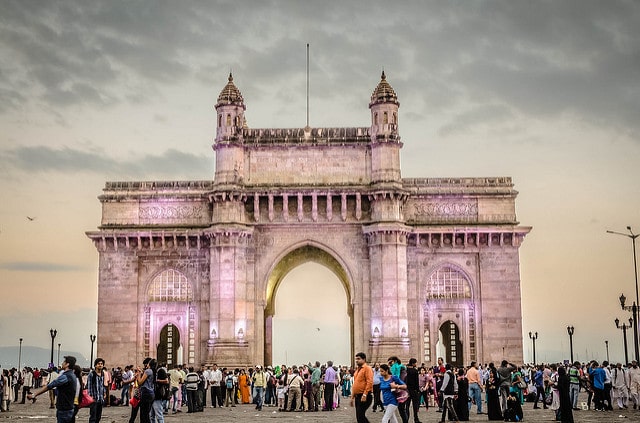
One of the many reasons why ‘Gateway of India’ finds its place in its list is how it is synonymous with the state and especially, its capital, the great Mumbai. It is a gigantic arcade that stands on the shores of Arabian Sea in the Apollo Bunder Area. The famous Taj Mahal Hotel is situated just opposite to it. The Gateway was built in 1924 to commemorate the visit of George V and Queen Mary to India. Designed by George Wittet, a famous British architect, the Gateway was built in the Indo-Sarcenic style. It is about 26 m high and there are four turrets. One of the attractive features in the structure is the intricate lattice work. Built in basalt, it is also one of the strongest monuments in India. Rupees 21 lakhs were spent on its construction, a massive amount of money in those days. Though the Gateway stood with pride and welcomed visitors, especially the British, who came by sea, it was quite ironic that it also served as the goodbye spot for the British as the last British ship sailed for England from the same spot. Today, it is one of the most popular tourist spots in Maharashtra and for both, domestic and foreign tourists, this place is a must-visit. In fact, it is the first spot on their list and invariably, even today, the Gateway of India is a gateway, from where tourists begin their sightseeing trip in Mumbai. All through the day and night, the spot brims with tourists, vendors and photographers, all the while the sea shining in its true glory and the monument standing as quietly as ever witnessing the past and the present.
2. Ajanta and Ellora Caves, Aurangabad
Though both these are two separate entities, they are mentioned as one and are collectively known as Ajanta-Ellora. A world heritage site, these caves are a marvel and a wonder that amazes not just your sight but also your soul. Apart from its architecture and carvings, it is also famous for its unique and beautiful paintings which still are present in its full glory as ever, even after centuries. These caves depict Buddhist art and its paintings have played an important role in the art of India as well. The way in which color and techniques have been used in these paintings that show human and animal forms has been exceptional. With art that is related to Hinduism and Jainism apart from Buddhism, the Ajanta-Ellora caves are also symbols to religious tolerance that existed in ancient India. The caves date back to 200 BC to 650 AD, and find mention in the travelogues of Hiuen Tsang and Fa Hien, Chinese travelers. The Ajanta Caves are located 107 km from Aurangabad and is situated in a panoramic ravine and resembles a huge horseshoe. There are 29 caves in Ajanta which are excellent depiction of art with the various sculptures, paintings and the cave carvings. There are both chaityas (shrines of Lord Buddha) and viharas or Buddhist monasteries. In addition to paintings that depict incidents from Buddha’s and other monks’ life and teachings, there are also elaborate and beautiful paintings inspired by Jataka tales. The Ajanta-Ellora caves are a must-visit for every person in the world as these caves present a splendid and unbelievable architecture and the excellent technology. These rock-cut caves take your breath away with its ornate style yet; you will find peace and serenity here, just as those Buddhist sculptures are in.
3. Bibi-Ka-Maqbara, Aurangabad
Yet another masterpiece monument from Aurangabad, Bibi-Ka-Maqbara is a mausoleum as the name suggests, and was built for Dilras Begum, the wife of Aurangzeb. It was built by their son Azam Shah. The mausoleum is also a unique structure where you can see signatures of a Hindu engineer and a Muslim architect as the inscriptions on it credit the design to architect Ata-ullah and its construction to engineer Hanspat Rai. One of the main features about the mausoleum is that it resembles Taj Mahal and also known as ‘Taj of Deccan’. Though the construction began with an aim to rival the Taj Mahal, it only ended up as a poor copy of the Taj due to decline in architecture and other factors. The complex in which the mausoleum stands is around 458 m. The char-bagh garden style of Mughals is another attraction, which adds to the beauty of the structure. Built with four minarets and on a square platform that stands quite high, the mausoleum is indeed a beautiful structure with splendid architectural beauty. There is also a mosque in the complex. It cost around more than 6 lakhs of rupees in those times. The Bibi-ka-Maqbara is regarded as one of the wonders of Maharashtra.
4. Sindhudurg Fort, Sindhudurg
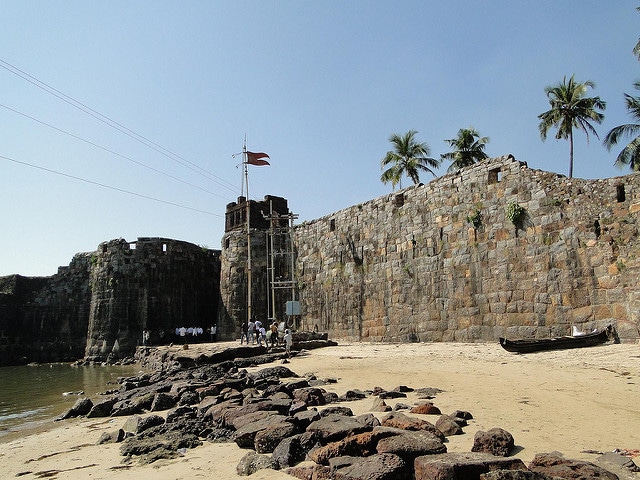
Though Emperor Shivaji built many forts in the state which stand strongly as ever even today, if there is one fort that points out to the vision and foresight of the Maratha King, then it has to be the Sindhudurg Fort. Located in the Konkan region in Sindhudurg district, the fort is one of the five sea forts built by Shivaji as a security measure against invaders that might have used sea to enter the region. It stands on the shore of Arabian Sea and the design and construction credit of this amazing fort goes to Hiroji Indalkar, the master architect under Shivaji. The fort was built to check foreign invaders and also to keep an eye of Siddis of Murud-Janjira, one of the main enemies of Shivaji. The fort built with huge stones, iron and lead still retains its magnificence. There is a watch tower in the fort and the main entrance was built in such a way that it couldn’t be noticed from the outside. The fort once was the residence of many soldiers and their families. Other attractions in the fort today are the three sweet water reservoirs which are full with potable water all through the year, a hidden passage, the hand and foot print of Shivaji, a temple dedicated to Lord Shiva and another temple dedicated to Shivaji himself, the latter built by Rajaram, Shivaji’s son.
5. Shaniwar Wada, Pune
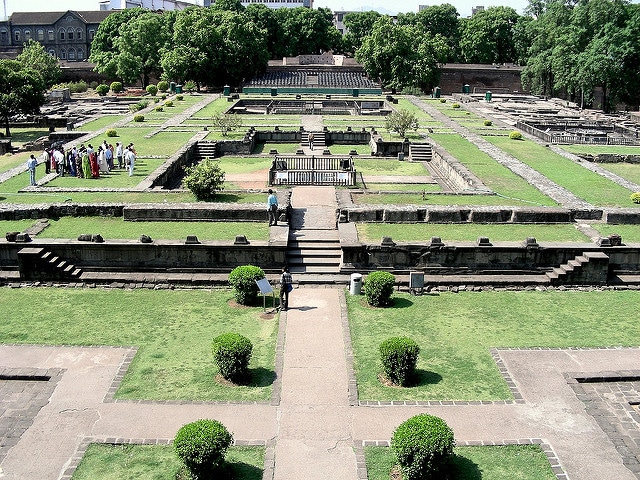
Pune has a number of historical structures and ancient monuments, some from Shivaji’s time and some earlier to it and many during the freedom struggle. Yet, if there is one monument that stands as a synonym to Pune’s historical heritage, then it has to the Shaniwar Wada. Built in 1746, it was intended as a residence for the Peshwa. Many additions were made after the fort was constructed such as the gates, court halls and more. It was once a huge seven-storied structure but most of it was burnt down in a fire in 1828. One of the attractions of Shaniwar Wada is the many gates, each known by a name. There is also a gate known by the second wife of Peshwa Bajirao, Mastani. The fountain in the form of a lotus with 16 petals stands in the complex which points to the excellent craftsmanship of those times. Today, a building stands here and is a protected monument. There are also many stories and legends about the fort. It is one of the major tourist attractions in Pune and every evening a light and sound show is held here for visitors.
A visit to these historical places will give you an idea about the history of state, about the legacy of Shivaji and Peshwas, the stamp left by the British and Indians’ resolve to protect and cherish these pieces of history for posterity. These structures are also symbols of man’s excellent talent and creativity.

